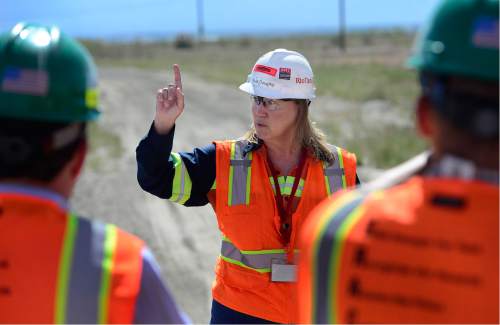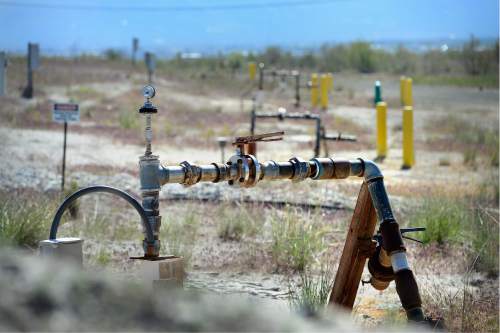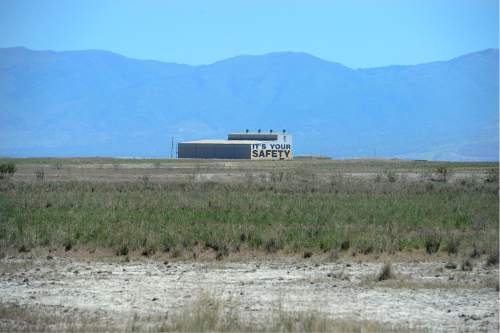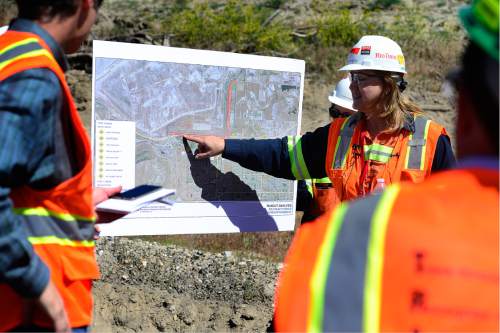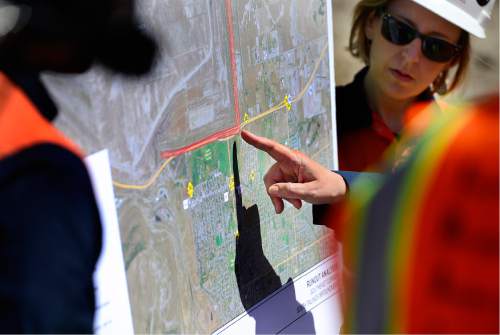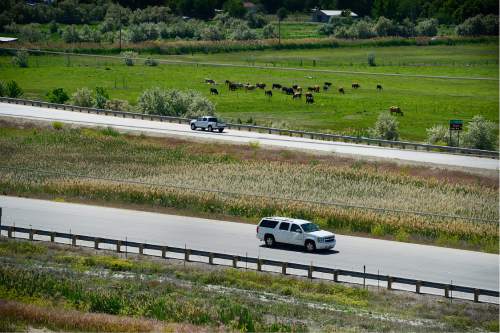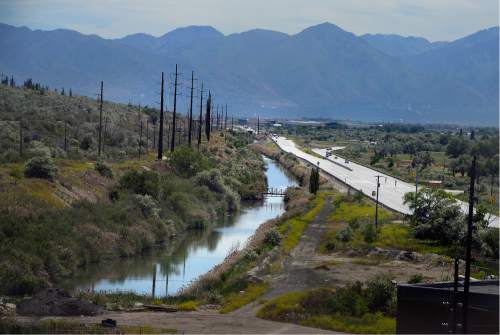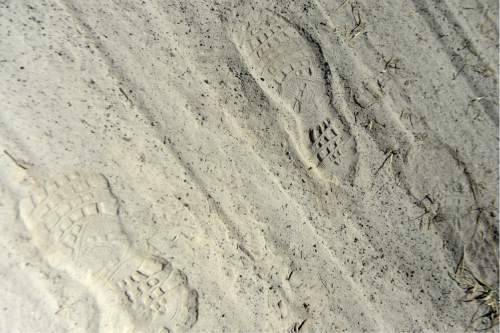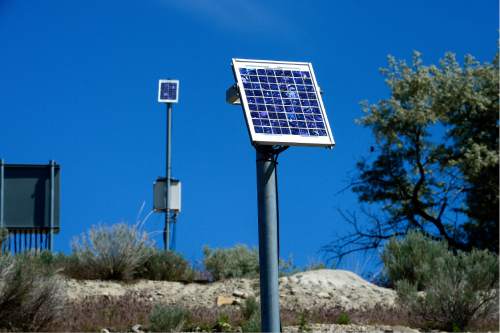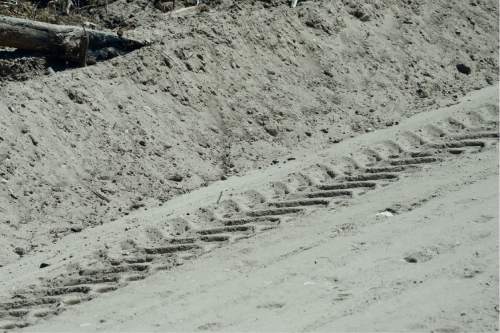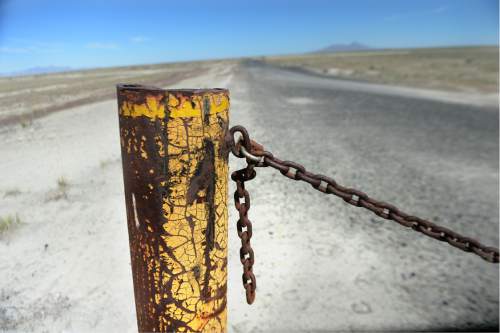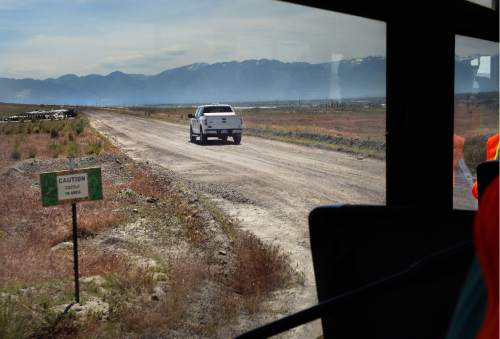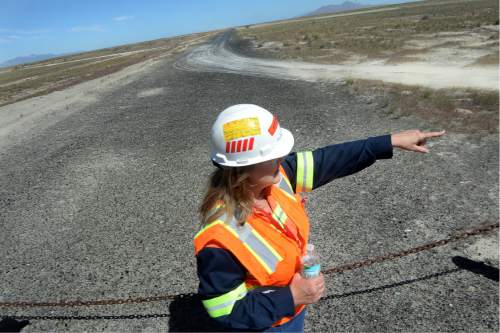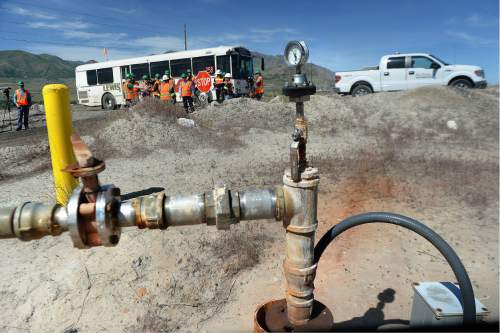Scott Sommerdorf | The Salt Lake Tribune
Paula Doughty, Rio Tinto Kennecott's Manager of Tailings and Water Services, describ
Scott Sommerdorf | The Salt Lake Tribune
Pumps draw water out of the tailings on the south tailings area near Hwy 201.
Rio T
Scott Sommerdorf | The Salt Lake Tribune
A view to the northeast of one of the buildings on Rio Tinto Kennecott property near
Scott Sommerdorf | The Salt Lake Tribune
On the bus for the Rio Tinto Kennecot media tour of the south tailings area. Rio Tin
Scott Sommerdorf | The Salt Lake Tribune
Paula Doughty, Rio Tinto Kennecott's Manager of Tailings and Water Services, describ
Scott Sommerdorf | The Salt Lake Tribune
Paula Doughty, Rio Tinto Kennecott's Manager of Tailings and Water Services, describ
Scott Sommerdorf | The Salt Lake Tribune
Hwy 201 as seen from the south tailings area at Rio Tinto Kennecott. It's possible t
Scott Sommerdorf | The Salt Lake Tribune
The "clarification canal" runs between the south tailings area at Rio Tint
Scott Sommerdorf | The Salt Lake Tribune
Tailings have the consistency of fine powdery sand inside the south tailings area at
Scott Sommerdorf | The Salt Lake Tribune
"Pizometers" at Rio Tinto Kennecott monitor the water content in the south
Scott Sommerdorf | The Salt Lake Tribune
Tailings make up the roadway inside the south tailings area at Rio Tinto Kennecott .
Scott Sommerdorf | The Salt Lake Tribune
Tailings stretch out for acres at the Rio Tinto Kennecott south tailings area.
Rio
Scott Sommerdorf | The Salt Lake Tribune
A bus carrying members of the media follows a Rio Tinto Kennecott truck as it drives
Scott Sommerdorf | The Salt Lake Tribune
Paula Doughty, Rio Tinto Kennecott's Manager of Tailings and Water Services, describ
Scott Sommerdorf | The Salt Lake Tribune
Pumps draw water out of the tailings on the south tailings area near Hwy 201.
Rio T
Scott Sommerdorf | The Salt Lake Tribune
Paula Doughty, Rio Tinto Kennecott's Manager of Tailings and Water Services, describes the south tailings area for media members on a tour to show what they are doing to mitigate possible damage from a catastrophic earthquake. Rio Tinto Kennecott is embarking on a pilot project at its inactive south slope tailings facility to improve the stability and safety of the site. The pilot project is a response to new seismic science that has recently become available, Friday, June 3, 2016.
Scott Sommerdorf | The Salt Lake Tribune
Pumps draw water out of the tailings on the south tailings area near Hwy 201.
Rio Tinto Kennecott is embarking on a pilot project at its inactive south slope tailings facility to improve the stability and safety of the site. The pilot project is a response to new seismic science that has recently become available, Friday, June 3, 2016.
Scott Sommerdorf | The Salt Lake Tribune
A view to the northeast of one of the buildings on Rio Tinto Kennecott property near the south tailings area.
Rio Tinto Kennecott is embarking on a pilot project at its inactive south slope tailings facility to improve the stability and safety of the site. The pilot project is a response to new seismic science that has recently become available, Friday, June 3, 2016.
Scott Sommerdorf | The Salt Lake Tribune
On the bus for the Rio Tinto Kennecot media tour of the south tailings area. Rio Tinto Kennecott is embarking on a pilot project at its inactive south slope tailings facility to improve the stability and safety of the site. The pilot project is a response to new seismic science that has recently become available, Friday, June 3, 2016.
Scott Sommerdorf | The Salt Lake Tribune
Paula Doughty, Rio Tinto Kennecott's Manager of Tailings and Water Services, describes the possible movement of the south tailings area as a result of a catastrophic earthquake. Rio Tinto Kennecott is embarking on a pilot project at its inactive south slope tailings facility to improve the stability and safety of the site. The pilot project is a response to new seismic science that has recently become available, Friday, June 3, 2016.
Scott Sommerdorf | The Salt Lake Tribune
Paula Doughty, Rio Tinto Kennecott's Manager of Tailings and Water Services, describes the possible movement of the south tailings area as a result of a catastrophic earthquake. Rio Tinto Kennecott is embarking on a pilot project at its inactive south slope tailings facility to improve the stability and safety of the site. The pilot project is a response to new seismic science that has recently become available, Friday, June 3, 2016.
Scott Sommerdorf | The Salt Lake Tribune
Hwy 201 as seen from the south tailings area at Rio Tinto Kennecott. It's possible that in a catastrophic earthquake that the tailings could flow out onto the westbound lanes of the roadway. Rio Tinto Kennecott is embarking on a pilot project at its inactive south slope tailings facility to improve the stability and safety of the site. The pilot project is a response to new seismic science that has recently become available, Friday, June 3, 2016.
Scott Sommerdorf | The Salt Lake Tribune
The "clarification canal" runs between the south tailings area at Rio Tinto Kennecott, and Hwy 201. The water is captured from irrigation and other uses and reused on the property.
Rio Tinto Kennecott is embarking on a pilot project at its inactive south slope tailings facility to improve the stability and safety of the site. The pilot project is a response to new seismic science that has recently become available, Friday, June 3, 2016.
Scott Sommerdorf | The Salt Lake Tribune
Tailings have the consistency of fine powdery sand inside the south tailings area at Rio Tinto Kennecott .
Rio Tinto Kennecott is embarking on a pilot project at its inactive south slope tailings facility to improve the stability and safety of the site. The pilot project is a response to new seismic science that has recently become available, Friday, June 3, 2016.
Scott Sommerdorf | The Salt Lake Tribune
"Pizometers" at Rio Tinto Kennecott monitor the water content in the south tailings area.
Rio Tinto Kennecott is embarking on a pilot project at its inactive south slope tailings facility to improve the stability and safety of the site. The pilot project is a response to new seismic science that has recently become available, Friday, June 3, 2016.
Scott Sommerdorf | The Salt Lake Tribune
Tailings make up the roadway inside the south tailings area at Rio Tinto Kennecott .
Rio Tinto Kennecott is embarking on a pilot project at its inactive south slope tailings facility to improve the stability and safety of the site. The pilot project is a response to new seismic science that has recently become available, Friday, June 3, 2016.
Scott Sommerdorf | The Salt Lake Tribune
Tailings stretch out for acres at the Rio Tinto Kennecott south tailings area.
Rio Tinto Kennecott is embarking on a pilot project at its inactive south slope tailings facility to improve the stability and safety of the site. The pilot project is a response to new seismic science that has recently become available, Friday, June 3, 2016.
Scott Sommerdorf | The Salt Lake Tribune
A bus carrying members of the media follows a Rio Tinto Kennecott truck as it drives on the south tailings area at Rio Tinto Kennecott, Friday, June 3, 2016. Rio Tinto Kennecott is embarking on a pilot project at its inactive south slope tailings facility to improve the stability and safety of the site. The pilot project is a response to new seismic science that has recently become available.
Scott Sommerdorf | The Salt Lake Tribune
Paula Doughty, Rio Tinto Kennecott's Manager of Tailings and Water Services, describes the south tailings area for media members on a tour to show what they are doing to mitigate possible damage from a catastrophic earthquake. Rio Tinto Kennecott is embarking on a pilot project at its inactive south slope tailings facility to improve the stability and safety of the site. The pilot project is a response to new seismic science that has recently become available, Friday, June 3, 2016.
Scott Sommerdorf | The Salt Lake Tribune
Pumps draw water out of the tailings on the south tailings area near Hwy 201.
Rio Tinto Kennecott is embarking on a pilot project at its inactive south slope tailings facility to improve the stability and safety of the site. The pilot project is a response to new seismic science that has recently become available, Friday, June 3, 2016.


